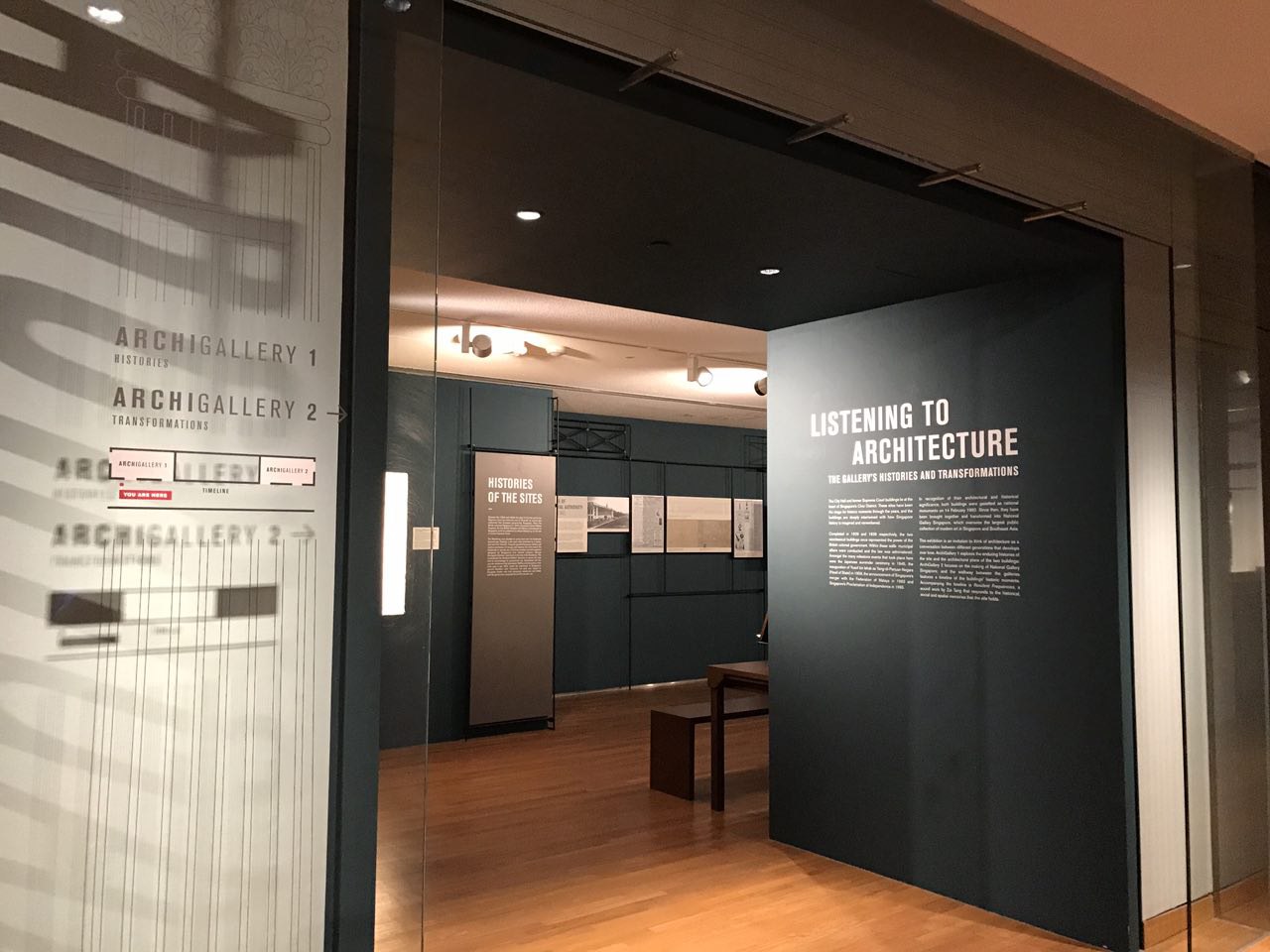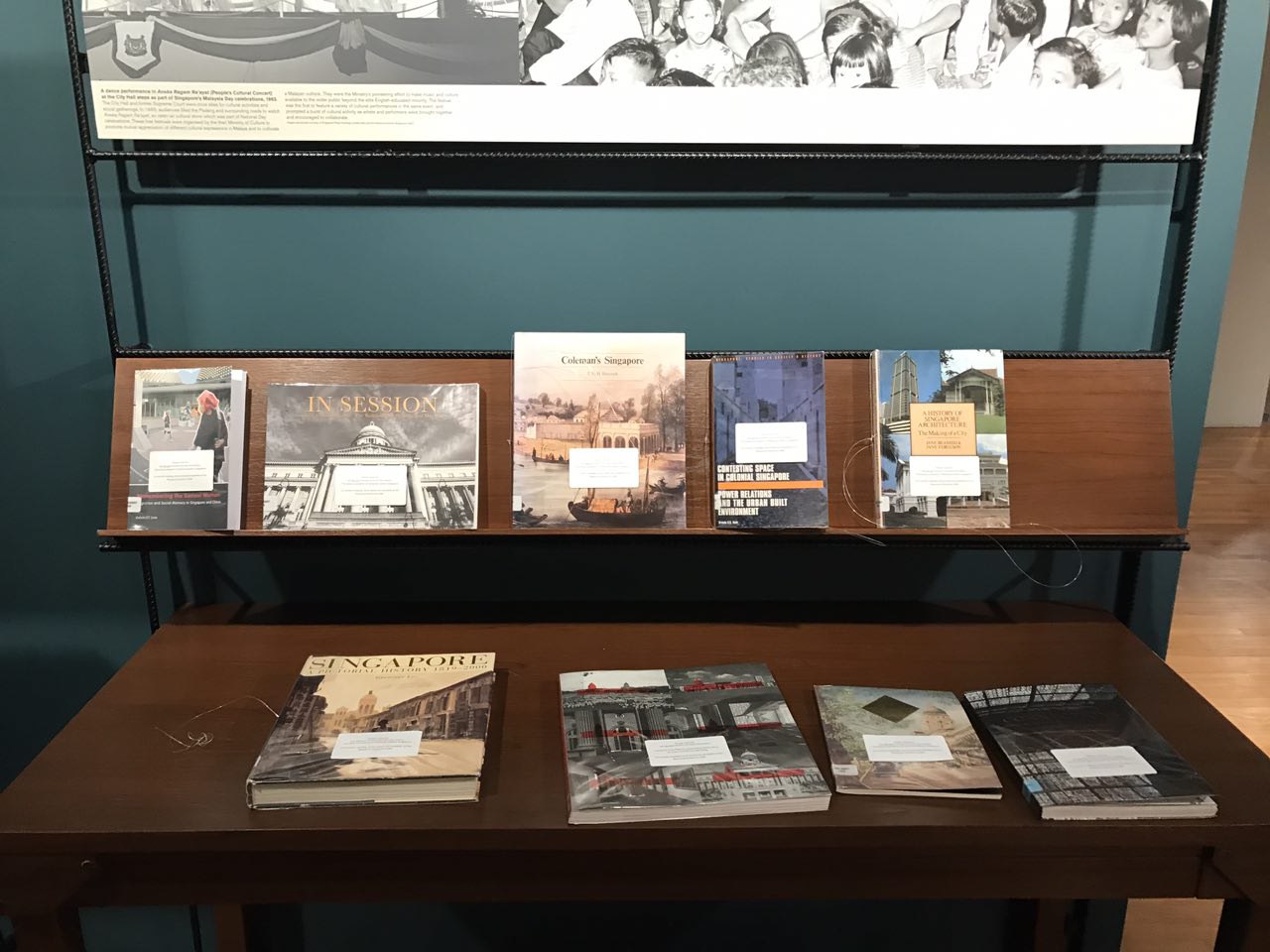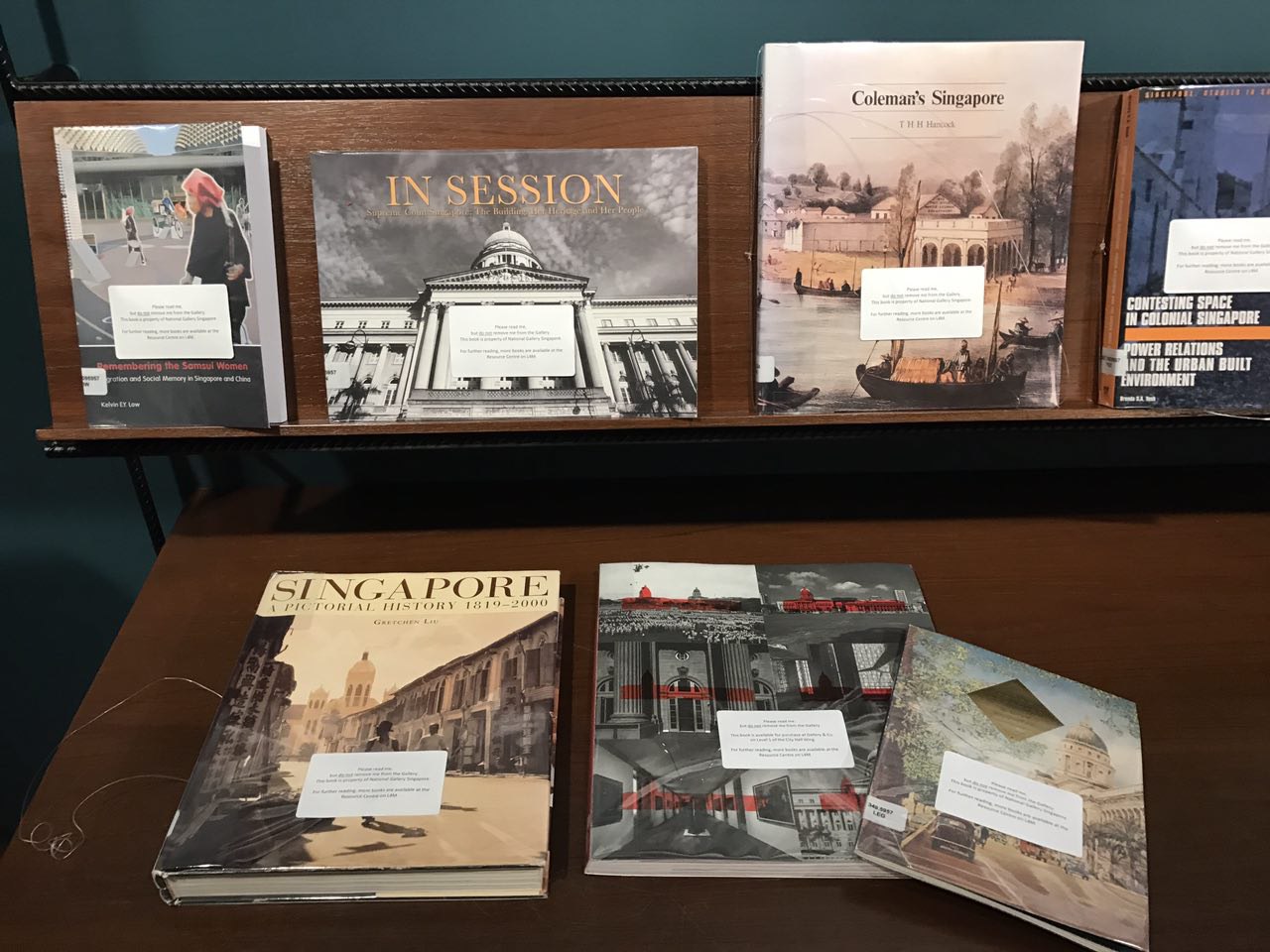Two of the Singapore Law Review’s articles are being displayed at Listening to Architecture: The Gallery’s Histories and Transformations, an ongoing exhibition at National Gallery Singapore. These articles discuss the Singapore War Crimes Trials at length. The trials were an epochal moment in Singapore’s history, where justice and accountability was served following the numerous atrocities committed during the Second World War. This special feature will provide essential information for anyone who wishes to familiarise himself with the war crimes trials and their continued relevance today.
The full articles can be also accessed at online at the following links:
Cheah W. L. “An Overview of The Singapore War Crimes Trials (1946-1948): Prosecuting Lower-level Accused” (2016) 34:1 Sing L Rev 1 [HeinOnline | LawNet]
Cohen, David "The Singapore War Crimes and Their Relevance Today" (2013) 31 Sing. L. Rev. 3 [HeinOnline | LawNet]
The Singapore War Crimes Trials Web Portal: a legal heritage and public outreach project on post-Second World War justice efforts in Singapore
Closely related to the two articles on display is the Singapore War Crimes Trials Web Portal [SGWCT Portal], a legal heritage and public outreach project conceived and spearheaded by Dr Cheah Wui Ling and Ms Ng Pei Yi. The SGWCT Portal is a freely accessible web portal on the war crimes trials held by the British military of Japanese Defendants in the aftermath of the Second World War in Singapore.
Unbeknownst to many, the British held 131 war crimes trials in Singapore where they tried over 400 Japanese military personnel from 1946-1948. Many of the crimes prosecuted are well-known today: among them are the Double Tenth Incident and the Singapore Chinese Massacre or ‘Sook Ching’, detainee abuse at Changi and Outram Road Gaols, deaths and ill-treatment on the Burma-Siam Railway. Hundreds of Asian civilians served as trial witnesses, and the trials were widely covered by the media. The British military kept meticulous trial transcripts and trial-related documentation. However, these trials have largely been “forgotten”.
Using graphics and data visualization tools, the Portal is the first of its kind in providing comprehensive information on the Singapore War Crimes Trials in the form of trial summaries, trial-related data, contextual information, and concise legal analysis. The interactive web-portal employs the latest technology and presents information in an interesting, visually refreshing and interactive manner. It also contains research materials and links for further research.
The SGWCT Portal makes information and sources on these trials available to researchers and others interested in Singapore’s history in an accessible and contextual manner. The broader aim of the SGWCT Portal is to inspire interest about the trials and international humanitarian law amongst researchers and lawyers, and to facilitate more research on these trials. The SGWCT Portal will also be of interest to members of the general public who are interested in learning about these trials, international justice, the crimes involved, and Singapore’s history.
In the long-term, we aim for the Portal to be a ground-up collaborative space for individuals and groups interested in the trials and this important part of Singapore’s history. For example, we plan to feature portraits of trial participants and survivors, as constructed from archival records, research material, and interviews. We also plan to feature more interactive features that will enable interested members of the public to get involved in the Portal.
If you would like to contribute or know of someone who has been involved in the trials and is willing to share his or her story, please do contact Dr Cheah Wui Ling or Ms Ng Pei Yi. The Portal has been generously supported by the National Heritage Board and Singapore Academy of Law.
If you wish to read more about the Portal and its 2016 launch that was organised with the kind support of the Singapore Law Review, please visit the following informative websites:
Review of articles on display at the ArchiGallery
In the following, we provide a brief review of both articles on display at the ArchiGallery: “An Overview of the Singapore War Crimes Trials” and “Singapore War Crimes Trials and Their Relevance Today”. Both articles are of great significance, not only for their exposition of the law and issues relating to the war crimes trials, but also for its focus on the liability of accused persons of a lower level. As Dr Cheah Wui Ling notes in her article, the spread and consolidation of international criminal law means that accountability for atrocity at the domestic and international level may lead to proceedings or prosecutions going beyond high-ranking leaders and direct perpetrators (at [44]). Thus, issues which surfaced in relation to the prosecution of lower-ranking accused persons pose not only historical interest, but modern-day relevance.
1. “An Overview of the Singapore War Crimes Trials (1946-1948): Prosecuting Lower-Level Accused”
“An Overview of the Singapore War Crimes Trials (1946-1948): Prosecuting Lower-Level Accused”, authored by Dr Cheah Wui Ling, is a perfect read for one attempting to acquaint himself with the Singapore War Crimes Trials. The author provides a chronological account of the war crimes trials, from its promulgation at the international level, subsequent establishment in Singapore, and the legal issues explored individually in the cases before the tribunal.
A historical context is necessary to appreciate the significance of the war crimes trials. Dr Cheah first explains how a system of holding perpetrators of wartime atrocities accountable was established following difficult political decisions, leading to the establishment of war crimes tribunals globally. She then details how such trials commenced in Singapore, against the volatile political environment and poor economic conditions in Singapore then. Notwithstanding the major administrative and humanitarian challenges in post-war Singapore, and the fact that political activity and defiance against British rule had took on a “youthful, militaristic” face, war crimes trials proceeded apace. Her preamble offers readers an appreciation of the global atmosphere and impetus in search of accountability for wartime atrocities, along with the national environment in which such trials took place.
War crimes trials differ from trials conducted in the modern-day courtroom. The legal framework and the general trial process differ from contemporary standards. For a reader to appreciate the legal issues that may have arose at trial, an understanding of the basic framework as to how war crimes trials were conducted is essential. In this respect, Dr Cheah provides a detailed technical overview of the trial process and the jurisdiction of the war crimes tribunals. The framework she furnishes allows readers to understand and appreciate the various legal issues which arose at trial. Above all, she notes that these trials were expedited in nature so the Courts could conduct as many trials as possible over a short period of time. In fact, neither strict procedural compliance nor sophisticated legal arguments were observed on the part of the Courts and participants respectively.
Legal issues arising in the course of war crimes trials shed light on the operation of the war crimes tribunals, and are relevant for the development of legal doctrines relevant for the work of modern day international criminal tribunals. Dr Cheah illustrates the legal issues through poignant cases conducted by the tribunals. Context is accorded to the legal issues with the article scribing the factual matrix and atrocity committed, allowing readers to better understand the dilemmas. Dr Cheah’s discussion is poised on several key legal issues faced:
- How omissions by commanders of detainee camps were explored as a ground of criminal liability;
- How organisational membership of the Kempeitai was discussed as an independent offence, or as evidence of a separate offence in establishing the criminal liability of the Kempeitai officers, and;
- How the defence of superior orders was raised and argued at trial.
Finally, Dr Cheah provides a critical evaluation of the legal arguments advanced by trial participants before the tribunals, providing the reader with a different perspective in analysing legal issues arising in the war crimes trials. She highlights notable angles: for instance, how criminal liability of some commanders of detainee camps appear to have been established solely on the basis of their omissions alone – despite the fact that trial actors did not clearly explain the approach taken towards omissions. On the issue of organisational membership, Dr Cheah notes that Courts have largely taken an individualised approach when determining guilt and sentences, and that proof of organisational membership was largely used as a means of overcoming evidential difficulties. In relation to the defence of superior orders, the article also highlights the difficulties in implementation at trial – due to unsatisfactory evidence provided by trial witnesses (who were attempting to shield their superior officers) and difficulties of identifying the origin of a particular illegal order. Dr Cheah also follows with a concordant explanation of how these salient legal issues from lower-level prosecutions before continue to feature in today’s international criminal law debates.
2. “The Singapore War Crimes Trials and Their Relevance Today”
“The Singapore War Crimes Trials and Their Relevance Today” by Professor David Cohen provides an insightful account of the ways in which legal issues raised in the course of the war crimes trials were dealt with by the military tribunals. Additionally, Professor Cohen also discusses how extra-legal factors, such as differences in military culture, training methods and cultural perceptions were resolved by the military tribunals in their respective decisions.
The war crimes trials should not be analysed in a vacuum, but against the historical and political context in which they took place. As Professor Cohen explains, the military tribunals were the products of a political decision made by the Allied Governments in their search of post-war accountability. As such, many of the trials were admittedly imperfect, and demonstrated the shortcomings of military personnel in grappling effectively with difficult issues of criminal law in the war crimes context. It is against this backdrop that he evaluates cases and discusses important legal and jurisprudential issues raised by the war crimes trials.
For instance, Professor Cohen highlights how results reached by the military tribunal was seemingly at conflict with the contemporary jurisprudence on command responsibility as a theory of liability. He does so through discussing the trial of Major Chida Sotomatsu and five others. It is well established that it is the de facto, rather than de jure authority held by an accused which will be determinative of his liability for criminal conduct perpetrated by individuals or units under his command authority. It was argued then, however, that the second accused (one Captain Komai), rather than Major Chida, was the de facto superior. The tribunal grappled with whether the other accused persons – individuals under the de facto superior’s command – should be regarded as subordinates of Major Chida for the purposes of attribution of responsibility? Professor Cohen further probes if Major Chida’s sentence of eight years’ imprisonment was justified, given that it was significantly lighter than that received by lower-level subordinates ordered by Captain Komai to carry out the criminal acts. After all, Major Chida remained commander of the camp and was privy to knowledge of the crimes committed by his subordinates.
Professor Cohen also suggests that the military tribunal’s lack of a general theory of responsibility contributed to its inadequacies in ensuring certainty, predictability and fairness. In particular, cases were not treated in a systematic manner where Defendants operated in contexts where multiple organisations bear responsibility for different aspects of an institution. Such issues most obviously manifest in cases where the defence of bureaucracy is raised, and defendants allege that the division of labour and responsibility within an organisation should relieve them of criminal liability. Generally, it is well-understood that all of the different strands of authority contribute to the eventual criminal outcome; thus culpability of the highest commander does not eliminate the responsibility of commanders down the chain of command. However, defendants managed with varying degrees of success in raising this defence even where their cases shared similar facts. As Professor Cohen comments, this reveals both the way in which organisational structure can be used rhetorically to redefine spheres of responsibility to meet the exigencies of a particular case, and that the defence can be used in a variety of ways. The absence of a general theory of liability, coupled with the malleability of the bureaucracy defence meant that cases could not be treated in a systematic matter, and trial of similarly-situated accused persons may still produce distinct results.
The most poignant legal issue discussed in the article is that relating to the defence of superior orders. Professor Cohen highlights the murky legal position on the defence, and how the military tribunals reached a position that flew in the face of the most fundamental principles of criminal law – in discarding the entire repertoire of criminal defences alongside with the discredited doctrine of superior orders. The defence of superior orders takes into account the burden placed upon ordinary soldiers in times of war, which weighs most heavily on the lower echelons of an organisation carrying out operational orders with the full weight of military discipline upon their shoulders. In conflating this defence with other excusatory defences of criminal law, the military tribunals seemed to throw the baby out with the bathwater. Professor Cohen raises a prime example of such in the trial of Mabuchi Setsuo and three others, where a conscripted subordinate surgeon (one Captain Wakamatsu) had courageously protested against an illegal order to perform an execution by lethal injection before eventually carrying out the procedure following threats from superiors. Although it was later commuted to life imprisonment, the tribunal’s initial sentence for Wakamatsu was death. The argument raised by Wakamatsu’s counsel that he had acted under duress – out of fear of the consequences if he disobeyed a Kempeitai order – was emphatically rejected. Wakamatsu’s protest regarding his dedication as a doctor who successfully treated severely wounded American and Allied Prisoners-of-War (a fact which American co-prosecutors testified to at trial) was similarly no excuse to his murder. The result of the case seemingly reflects that the tribunal had simply discarded the entire repertoire of criminal defences, thus departing from fundamental principles of criminal law. After all, duress as a defence remains recognised, and exists to excuse the unjustifiable and illegal conduct of those who had been placed in extraordinary circumstances.
Professor Cohen also considers whether subjective standards (such as those stemming from different military cultures, or different forms of military training) should be considered by war crimes tribunals in the attribution of responsibility. In discussing the trial of General Otsuka Yoshio and forty-three others for the mistreatment of POWs and civilians in Outram Prison, he notes that subjective standards appear to have been disregarded. In that case, conviction of the officers was upheld for it remained the duty of the Defendants to report the bad conditions at Outram prison to the relevant headquarters; it did not matter that the Japanese conception of “staff officers” was one who solely assists the commander from within HQ and is generally not responsible for incidents outside their respective headquarters.
However, Professor Cohen also questions if objective standards may be adopted fairly, in relation to ordinary soldiers who may not be well versed with the workings of international law. He refers to the decision of the US tribunal in the trial of the Commander of the Japanese Navy, Admiral Toyoda. Citing the decision of the tribunal at length, Cohen notes that an accused is tried on grounds common to all civilizations, at standards which countries have willingly subscribed to as universally accepted standards and recognised laws of war. Nonetheless, an objective standard, which may apply without objection to high-ranking soldiers well versed in international law, may not be justifiably applied to ordinary Japanese soldiers who may fail to appreciate if an “order” is manifestly unlawful or outside the scope of the defence of superior orders. He also argues that it is precisely in such situations that a doctrine of excuse should apply.
Finally, Professor Cohen considers if different cultural perceptions of fairness, justice and due process produced different views about constituents of a fair trial, and its attendant impact on the kinds of procedural justice which Defendants of the war crimes trials were entitled to. For instance, he notes that acquittals were often reached in cases where tribunals were cognizant of the different notions of procedural justice inherent in different national legal systems and how that could have contributed to the perceived legality of an illegal wartime order. More importantly, he notes that conflicts between the civil law and common law understandings of procedural justice continue to occur in contemporary war crimes tribunals.
Do browse through these articles, which are now displayed at ArchiGallery 1 of the National Gallery. You may locate bound copies of these articles in the drawers underneath the reading table.
For further information on subscription or purchasing printed copies of the Singapore Law Review, please contact us at [email protected].
Article Credits: Professor Cheah Wui Ling and Ms Ng Pei Yi
Writer: Perry Peh
Photo Credits: Agnes Lo
Click here for more news.








